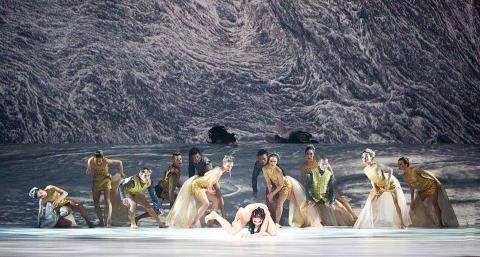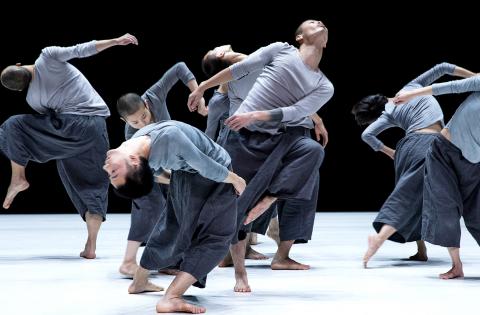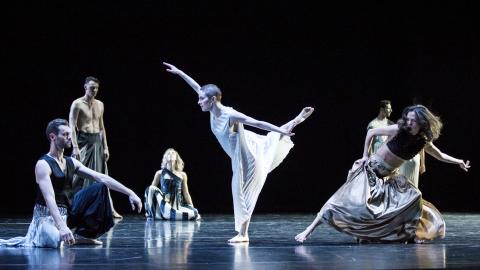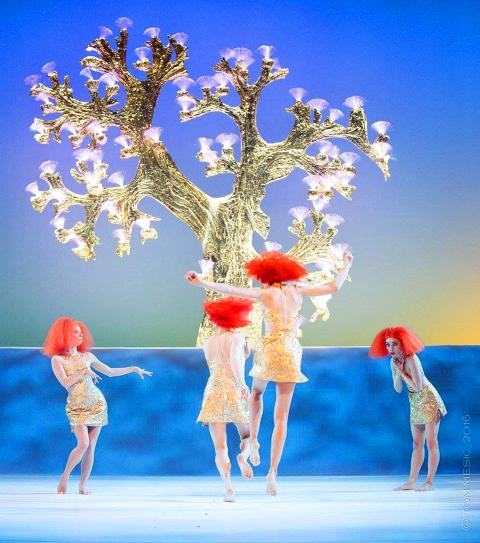There is a substantial amount of dance going on around Taiwan this weekend, from Taipei to Kaohsiung, from small festivals to major appearances by foreign companies dancing works by Taiwanese choreographers.
One of the most eagerly awaited productions is that of the TANZLIN.Z company from Linz, Austria, which will perform Yilan County-born choreographer Lin Mei-hong’s (林美虹) The Little Mermaid at the National Taichung Theater (NTT) on Saturday and Sunday afternoons.
While Lin is known in Taiwan, her career has been in Europe, where she has lived for more than four decades, first as a dance student and later as artistic director of German municipal ballet companies in Plauen, Dortmund and Darmstadt. She moved to Austria in 2013 to head the TANZLIN.Z at the Landestheater Linz.

Photo courtesy of Tom Mesic
In addition to her works for those companies, she has also choreographed for operas, musicals and plays in Germany, Austria, France, Spain and Sweden.
Eight years ago she brought the Tanztheater des Staatstheaters Darmstadt to Taipei’s National Theater to perform her 2009 production, Schwanengesang (“Swan Song”). It was the first time one of her European dances had been performed in Taiwan and the dance-theater production, inspired by Belgian poet George Rodenbach’s 1892 novel Bruges-la-Morte, left audiences eager to see more of her work.
For The Little Mermaid production, which premiered last year, Lin combined the Hans Christian Andersen classic tale of a mermaid princess who falls in love with a human prince, and Oscar Wilde’s The Birthday of the Infanta, a story about a dwarf who falls in love with a beautiful princess and is mocked as a result.

Photo courtesy of Fan Xi
The common thread linking the two ballets is the frustrations encountered by the main characters’ pursuit of love and their destructive internal struggles in the face of rejection.
The show, set to a score by Alexander von Zemlinsky and Franz Schreker, with costumes and sets by Dirk Hofacker and lighting by Johann Hofbauer, won this year’s Austria Music Theater Prize.
It will be performed in Taichung’s Grand Theater and runs 100 minutes, with a 25-minute intermission.

Photo courtesy of Pedro Greig
Many people have complained about the National Taichung Theater’s programming of two dance productions at the same times on weekends, instead of staggering the shows so that people traveling from Taipei or elsewhere could see both in one day if they wanted, a scheduling system in evidence during the Taiwan International Festival of Arts (TIFA) program this spring.
Someone appears to have heeded the criticism, and so people who want to see Lin’s show as well as Beijing-based TAO Dance Theater’s (陶身體劇場) show 5 and 9 in The Playhouse can do so on Saturday, as TANZLIN.Z is performing a 2:30pm matinee and TAO’s first performance is at 7:30pm. On Sunday, both troupes will perform at 2:30pm.
TAO, founded in March 2008 by dancers Tao Ye (陶冶), who was then just 23, and Wang Hao (王好), made its Taiwan debut in April 2014 as part of the Novel Hall Dance Series in Taipei, and were back again in November 2016 at NTT and then again last year to perform at the Cloud Gate Theatre in New Taipei City’s Tamsui District (淡水).

Photo courtesy of Tom Mesic
Tao’s choreographic style is minimalist and unique, the movements building on overlapping circular forms, with the dancers — uniformly clad and with closely shaven heads — often maintaining close physical connections with one another, appearing to move in a united form to the point where it is difficult to know where one begins and another ends.
Tao’s works are titled simply by the number of dancers in each.
In Taichung, the company will perform 5, created in 2013 and seen during the 2014 visit, and 9, which premiered last year and broke with Tao’s pattern of repetition, with the dancers moving individually as well as collectively.
The NTT was one of five in Europe, Asia and Australia to coproduce 9.
The show runs about 75 minutes, including an intermission, but the theater warns that latecomers will not be admitted.
Down at the beautiful new Weiwuying National Kaohsiung Center, the Sydney Dance Company is making a return appearance in Taiwan with a double bill of Rafael Bonachela’s Lux Tenebris and Full Moon (大明) by Cloud Gate 2 (雲門 2) artistic director Cheng Tsung-lung (鄭宗龍).
Lux Tenebris explores light and darkness to an electronic score by composer Nick Wales, with costumes by Aleisa Jelbart and lighting and stage design by Benjamin Cisterne.
Full Moon, which premiered in April last year and was Cheng’s first major work for a non-Taiwanese company, is a dance about the power of the moon and Chinese mythology about the moon, as told through eight characters.
It is set to a score by Lim Giong (林強), with costumes by Fan Huai-chih (范懷之), who did such amazing work for Cheng’s Dream Catcher (捕夢) for Cloud Gate 2, which premiered in October last year.
For dance fans who want to stay in Taipei, there is the 13th Tsai Jui-Yueh International Dance Festival (第十三屆蔡瑞月國際舞蹈節) (see “The intersection of politics, rights and dance” on page 13 in yesterday’s paper) and the Taiwan International Darkness Dance Festival (台灣國際黯黑舞蹈節) at Huashan 1914 Creative Park’s (華山1914文化創意產業園區) Umay Theater (烏梅劇院).
The Darkness festival opens today, with three performances — 9am, 2pm and 6pm — and a fourth on Saturday at 7pm, but there are just a handful of seats left for each of the shows.
This story has been updated since it was first published.
Performance Notes
WHAT: The Little Mermaid
WHEN: Saturday and Sunday at 2:30pm
WHERE: The Grand Theater at the National Taichung Theater (台中國家歌劇院), 101, Huilai Rd Sec 2, Taichung City (台中市惠來路二段101號)
ADMISSION: NT$700 to NT$2,200; available at the NTT box office, online at www.artsticket.com.tw and at convenience store ticket kiosks. There are just a score of NT$1,500 tickets left for Saturday’s show, but lots of options for Sunday’s
WHAT: TAO Dance Theater: 5 & 9
WHEN: Saturday at 7:30pm and Sunday at 2:30pm
WHERE: The Playhouse at the National Taichung Theater (台中國家歌劇院) 101, Huilai Rd Sec 2, Taichung City (台中市惠來路二段101號)
ADMISSION: NT$500 to NT$1,200; available at the NTT box office, online at www.artsticket.com.tw and at convenience store ticket kiosks
WHAT: Lux Tenebris & Full Moon
WHEN: Saturday at 7:30pm and Sunday at 2:30pm
WHERE: The Playhouse at the Weiwuying National Kaohsiung Center (衛武營國家藝術文化中心) 1, Sanduo 1st Rd, Kaohsiung City (高雄市三多一路1號)
ADMISSION: NT$300 to NT$1,600; available at the Weiwuying box office, online at www.artsticket.com.tw and at convenience store ticket kiosks

April 14 to April 20 In March 1947, Sising Katadrepan urged the government to drop the “high mountain people” (高山族) designation for Indigenous Taiwanese and refer to them as “Taiwan people” (台灣族). He considered the term derogatory, arguing that it made them sound like animals. The Taiwan Provincial Government agreed to stop using the term, stating that Indigenous Taiwanese suffered all sorts of discrimination and oppression under the Japanese and were forced to live in the mountains as outsiders to society. Now, under the new regime, they would be seen as equals, thus they should be henceforth

Last week, the the National Immigration Agency (NIA) told the legislature that more than 10,000 naturalized Taiwanese citizens from the People’s Republic of China (PRC) risked having their citizenship revoked if they failed to provide proof that they had renounced their Chinese household registration within the next three months. Renunciation is required under the Act Governing Relations Between the People of the Taiwan Area and the Mainland Area (臺灣地區與大陸地區人民關係條例), as amended in 2004, though it was only a legal requirement after 2000. Prior to that, it had been only an administrative requirement since the Nationality Act (國籍法) was established in

With over 80 works on display, this is Louise Bourgeois’ first solo show in Taiwan. Visitors are invited to traverse her world of love and hate, vengeance and acceptance, trauma and reconciliation. Dominating the entrance, the nine-foot-tall Crouching Spider (2003) greets visitors. The creature looms behind the glass facade, symbolic protector and gatekeeper to the intimate journey ahead. Bourgeois, best known for her giant spider sculptures, is one of the most influential artist of the twentieth century. Blending vulnerability and defiance through themes of sexuality, trauma and identity, her work reshaped the landscape of contemporary art with fearless honesty. “People are influenced by

The remains of this Japanese-era trail designed to protect the camphor industry make for a scenic day-hike, a fascinating overnight hike or a challenging multi-day adventure Maolin District (茂林) in Kaohsiung is well known for beautiful roadside scenery, waterfalls, the annual butterfly migration and indigenous culture. A lesser known but worthwhile destination here lies along the very top of the valley: the Liugui Security Path (六龜警備道). This relic of the Japanese era once isolated the Maolin valley from the outside world but now serves to draw tourists in. The path originally ran for about 50km, but not all of this trail is still easily walkable. The nicest section for a simple day hike is the heavily trafficked southern section above Maolin and Wanshan (萬山) villages. Remains of